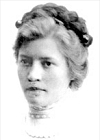


July 24, 1889 - September 16, 1971
Agnes Meyer Driscoll was one of America's leading cryptanalysts during the early part of the twentieth century and was sometimes described as "the first lady of naval cryptology." She was born in Geneseo, Illinois in 1889. She attended Otterbein University in Columbus, Ohio, from 1907 to 1909, then Ohio State University where she studied mathematics, statistics, physics, music, and languages (German, French, Latin, and Japanese). She received an A.B. degree from Ohio State in 1911. Upon graduation she accepted a job as Director of Music at Lowry Phillips Military Academy in Texas, teaching there until 1914 when she became head of the mathematics department at Amarillo High School in Texas.
Meyer enlisted in the Naval Reserve as a Chief Yeoman in 1918 where she began her career as a cryptanalyst (cryptanalysis is the science of breaking codes.) Her active duty ending in July, 1919. The following year she joined the Department of Ciphers at Riverbank Laboratories in Chicago, Illinois, on loan from the Office of the Director of Navel Communications. In 1921, Edward Hebern, the inventor of the first machine to use the rotor principle to encrypt coded messages, "advertised an 'unbreakable' cipher in a marine magazine, but Miss Agnes Meyer, a cryptanalyst...solved the sample message" [2]. Hebern in turn then hired Meyer for cryptologic help, but his company ultimately failed. It was during this period that Meyer married Michael Driscoll, a Washington lawyer. In 1924 she returned to the Office of the Director of Naval Communications. There she helped teach cryptology to Lawrence Safford, the first head of the Navy's Cryptographic Research Desk, as well Joseph Rochefort, a major figure in the U.S. Navy's cryptologic and intelligence developments from 1925 to 1947, and Thomas Dyer, who led the team that was responsible for most of the breakthroughs in reading Japanese naval communications during World War II. Susan Lujan writes that "she was often the first in a group of skilled analysts to break new systems and codes considered milestones in the history of the field, including solutions to the Hebern cipher machine, the Japanese Orange Grand naval Maneuvers cipher, the Japanese Red Book and Blue Book superenchiperments, and more" [1]. Breaking the Japanese Blue Book required solving both the code and the overlaying cipher simultaneously. Rear Admiral Edwin Layton described "Miss Aggie" in his book And I Was There:
In the navy she was without peer as a cryptanalyst. Some of her pupils, like Ham Wright, were more able mathematicians but she had taught cryptanalysis to all of them, and none ever questioned her superb talent and determination in breaking codes and ciphers. She understood machines and how to apply them. In 1937 she would share the fifteen-thousand-dollar prize granted by the Senate for her contribution to developing a cipher machine with Lieutenant Commander William F. Gresham. But her principal talent was her ability to get to the root of a problem, sort out its essential components, and find a way to solve it. Among her uniformed colleagues, she was held in the highest esteem throughout her long career....Agnes Driscoll served as a "principal cryptanalyst" for the Navy until December 1950. From 1950 to 1959 she worked for the Armed Forces Security Agency, the precursor of today's National Security Agency, retiring from active federal service on July 31, 1959. She died in 1971 and was buried in Arlington National Cemetery.